Chimayó: A place of healing and miracles
Posted by Alexandra Salinas
“If you are a stranger, if you are weary from the struggles of life, whether you have a handicap, whether you have a broken heart, follow the long mountain road, find a home in Chimayó.” ~poem found in the chapel
I believe that a crucial aspect of a person’s pilgrimage is knowing their thoughts and feelings before, and then their reflection of the journey, once it has all been said and done. Everyone starts his or her personal journey for a particular reason; everyone has a driving motive. Mine was my mother.
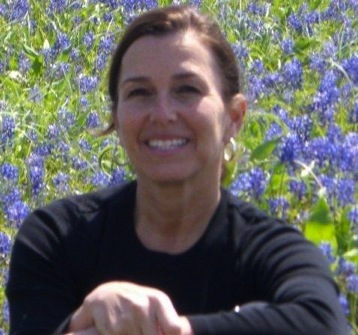
About eight years ago, my mother was diagnosed with Multiple Sclerosis, MS when abbreviated. Her symptoms appeared gradually, but nevertheless were debilitating. My once very active mother who never stopped, was now bed ridden and, frankly, pretty miserable. Her transition into her new self has without question been the most challenging stage of her life. Unfortunately, the disease varies from day to day, and she never knows how she is going to wake up feeling. Learning how to live with MS is a lifelong progression.
My mother was never a fan of going to the doctors or taking prescribed medicines, but when considering MS treatment, lots of medication comes with the territory. After spending a few years testing and trying everything they had to offer, my mother turned to alternative medicine. She spent her newfound time researching and delving into the fairly new options of treatment. Those options included things like going to the chiropractor and giving acupuncture a shot. The more faith and willingness you approach this new form of healing with, the more, I believe, you get out of it.
At a family dinner about two years ago, my mother announced that she was going to go on a pilgrimage to this little town in New Mexico: Chimayó. She spoke with so much conviction and she truly believed that going on this journey would heal her, or at least put her on the right path. The men in my family pretty quickly decided this wasn’t the best idea. I, on the other hand, decided to go with her. We were all worried about her newfound sense, of what we believed to be, false hope.
In the month before our pilgrimage, my mother fell ill and whatever chance of her making it to Chimayó was taken away. We called off the trip and no one ever really brought it up. A couple months later, I found myself going on a road trip across the southwest, and as fate would have it, my friend wanted to stay in Santa Fe, New Mexico for a week or so. Upon arriving in Santa Fe, I decided to go on the pilgrimage for my mother.
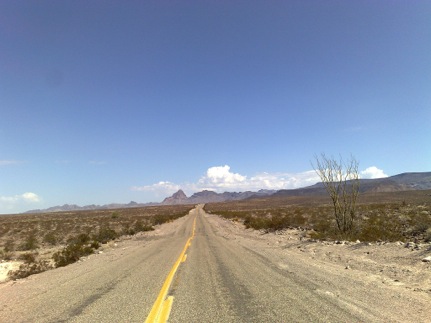
Unbeknownst to me, there apparently is a very organized way to go about this and it actually take months of planning and preparation. I just looked up the route on google maps, put on my tennis shoes, filled my backpack with water, and started my journey. Now when they say, follow the long mountain road, they are in no way kidding. This walk was very long, and doing it alone made it all the more challenging. It took me about ten hours or so, probably more, and I arrived at the little town of Chimayó right as the sun was setting.
Brilliantly, having made absolutely no plans, I found myself in Chimayó with no place to sleep, but I ended up meeting some incredible people. They had done their pilgrimage from Albuquerque, New Mexico, and were more than happy to share their campsite with me. As the village went to sleep, the campfire came alive. Stories and beer were being shared as if we were a family rejoining for the first time in a long while.
It was there that I learned about the history behind this fascinating place, I learned about the miracle of healing, I learned about the purpose and reasons people embark on this pilgrimage, and I started believing in the magic of Chimayó.
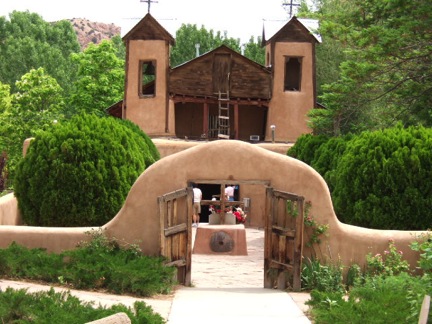
Spanish settlers settled Chimayó in the late 1800’s. They were originally attracted to the fertile valley the land rested on, which also provided access to the Santa Cruz River. The descendants of the early settlers have truly honed their skills and are known for their quality weaving, their red chili crops, and their traditional Hispanic arts. The people who inhabit Chimayó are warm and friendly. Whether it is trying their chili powder out of pistachio shells or participating in the song and dance that fills the street, you must throw yourself into the culture.
Some call Chimayó the “Lourdes of the west” or even the “Lourdes of America” because it is home to a legend involving miraculous healing. It is said, hundreds of years ago, there were two men walking over the land that is now Chimayó. As they were walking, they saw this light coming from the earth. Immense curiosity called upon them to dig into the ground, and see where this light was coming from. It is said that they came across this sacred and holy crucifix that was in the ground.
The local people declared the site a holy ground and word started to spread across the country. Believers began to pray at the site, and would walk away feeling renewed, spiritually and physically. Eventually the cross was unearthed, and a chapel was built around the site. In the future, the red dirt comprising the holy ground was said to have medicinal qualities.
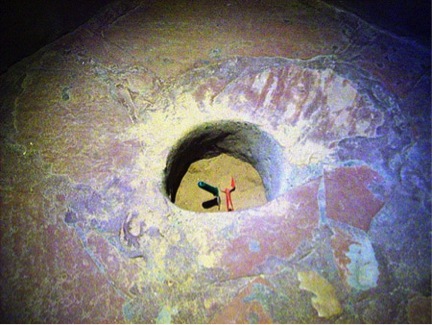
The chapel is now referred to as El Santuario de Chimayó, and is a destination for people searching to be healed or restored. It is a place full of this vivacious energy and hope. Upon walking into the chapel, there is a little room where you can place a candle for a loved one. Then you come across the room of church pews and the altar.
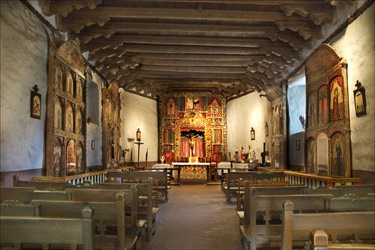
Upon entering the chapel, everything and everyone grows silent. I have never appreciated the beauty of pure silence until that moment. You speak with your eyes and you realize that everyone is experiencing the reverence of the chapel in their own way. It is uniquely an event that you experience with all five senses. You see the splendor, you smell the rusticity, you taste the presence of something so much greater than yourself, you feel the papers and petitions of hope people have left on the altar, and you hear the shuffling of curiosity, anticipation, and enthusiasm.
As you turn left at the altar, you come to this room full of crutches, wheelchairs, casts, crucifixes, and photos. Presumably, all representations of loved ones who are either enduring sickness or who have survived it. For me, this was the most powerful part of my journey. This room is dedicated to displaying so much pain and struggle, but it is also a tribute to finding peace and having triumphed.
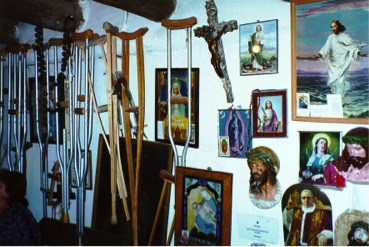
As you turn right, you will find yourself in the room called El Posito, which translates to little hole or well. This is the room containing the holy dirt. Here, you will find people standing or sitting in the dirt, you will see people consuming or bathing themselves with the dirt, and you will see people filling Ziploc bags or little containers of this dirt to keep with them for the rest of their lives.
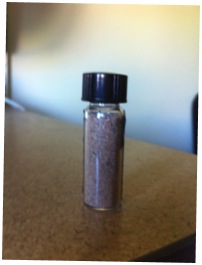
As you exit the chapel you find yourself lingering in the courtyard, not really ready to let go of the experience and return to reality. In order to prolong their stay, this is where people start to open up about their journey and explain to you their reasoning. I met people who were there for a family member, praying for their recovery. I met people who were able to endure the journey and who were ailing from cancer or similarly traumatic diseases. I met people who were trying to forgive themselves for personal reasons.
The person who had the most long term effect on me, someone who I find myself thinking of from time to time, was there in thanks for her own miracle. At the age of 39, she had been diagnosed with stage four cancer, and she and her husband found themselves embarking on this pilgrimage soon after. She said that she didn’t so much believe in miracles as was she just at a loss and hoping for one. Almost exactly a year later, her doctor told her she was in remission. She was healed.
I was not a believer. I didn’t take it seriously when I was started my journey, not even really when I had made it. It wasn’t until that night at the campfire that I opened up my mind. And it wasn’t until I walked into that chapel, that whatever higher power was at work consumed me. It was a powerful experience, you could even call it a divine experience, because I stayed there, and I prayed, I wrote a petition and placed it on the altar, and I had a cross necklace blessed by the pastor for my mother. I realized that there is not one way to make that pilgrimage and it really does not matter how you get there. What matters is how you immerse yourself in Chimayó, how you choose to experience the wonder, and what you take away from it all.
It is two years later, and my mother is still living with MS. There are still days full of struggle, but according to her, there are a whole lot more full of peace. I think that making that journey for her will probably be one of the best decisions I have ever made. I will never forget returning home from my trip, sharing my story, and giving her the cross necklace. She still wears it to this day; it never comes off, much like the hope and optimism that she now armors herself with each day.
Bibliography:
- Santuario De Chimayo, Place of Miracles - Part 1. Dir. ParanormalTV. YouTube. YouTube, 07 Apr. 2010. Web. 01 Oct. 2012. <http://www.youtube.com/watch?v=LStFhVtMZkw>.
- "¡Bienvenidos! Welcome..." Chimayo, Historic Village in the Heart of Northern New Mexico. N.p., n.d. Web. 01 Oct. 2012. <http://www.chimayo.us/>.
- Holmes-Rodman, Paula E. "“They Told What Happened on the Road”: Narrative and the Construction of Experiential Knowledge on the Pilgrimage to Chimayo, New Mexico." Intersecting Journeys: The Anthropology of Pilgrimage and Tourism. By Ellen Badone and Sharon R. Roseman. Urbana: University of Illinois, 2004. N. pag. Print.
